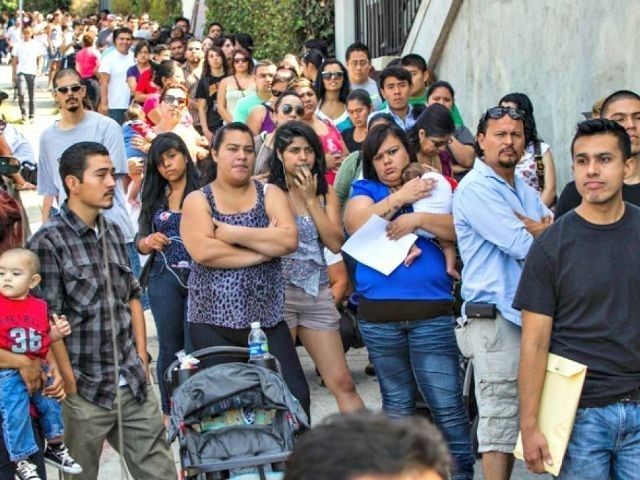A report issued by the non-partisan Center for Immigration Studies finds that the U.S. Department of Agriculture’s Supplemental Nutritional Assistance Program (SNAP) — commonly known as food stamps — oftentimes disproportionately benefits families that include illegal aliens over all-citizen families.
In most states, families including illegal aliens can receive more taxpayer-funded benefits, because many states will ignore an ineligible alien’s income when calculating, or prorating, the family’s total income. An illegal alien’s earnings won’t count towards the income cap, allowing “mixed” families to potentially collect more benefits than they would if they were all U.S. citizens.
“The proration formula is inherently unfair to the citizen family (or a family of eligible green card holders) as the system gives tax dollars to one family and not the other because the benefitting family has an ineligible alien as the breadwinner. It is biased against those here legally, and biased in favor of those whose presence is against the law (or who have secured their green cards quite recently),” CIS fellow David North writes.
Incidentally, this strange arrangement only benefits the better-off families including ineligibles; in the case of a family of three it would allow mixed families with incomes of more than $30,000 a year to receive benefits. Proration does not create opportunities to receive benefits for really low income mixed families, as they are eligible already. A further irony is that politicians have accepted this bias in favor of a population that not only includes no voters, it includes very few people who will vote in the next five to 10 years.
Few people are aware of, let alone understand, this unusual situation. While SNAP is a national program, states and counties add more complications to determining exactly how much families, including those with illegal aliens, can receive. CIS suggests bringing it to governors’ attention with a pointed question: “As you may or may not know, the state administration, in the food stamps program, has taken a bizarre position that it is easier for families with illegal aliens as the wage earners to get food stamps than for all-citizen families. In these cases the wages of illegal aliens are not fully counted when food stamps eligibility is calculated, while the citizen’s wages are always counted. Do you support this overt bias against citizen families? Your office can change the policy.”
Estimates regarding the size of the illegal alien population in the U.S. range from 11 million to 30 million, making the impact of the program’s formula significant. California, Texas, New York, Florida, and Illinois have the largest illegal alien populations.
“Chances are the governor does not have a clue about the subject, but he or she may call the appropriate cabinet member and change may ensue,” North writes. “Thus, state legislators, the governors, and the state house press might be contacted in an effort to eliminate this strange, anti-citizen governmental program.”
Third World immigrants, especially illegal aliens, cost the American taxpayer enormous amounts of money each year in welfare, crime, healthcare, and education expenses. Immigrant-headed households use 41 percent more welfare than native households. All illegal alien minors are entitled to a taxpayer-funded education in U.S. schools thanks to a liberal Supreme Court ruling, Plyler v. Doe (1982), which also unilaterally grants U.S. citizenship to anchor babies, encouraging further illegal immigration and contributing to ballooning welfare costs.
Continuing surges of illegal immigration from Central America will cost over $1 billion in 2017, with American taxpayers projected to shell out $17,613 per unaccompanied illegal alien minor smuggled into the country in 2017.

COMMENTS
Please let us know if you're having issues with commenting.